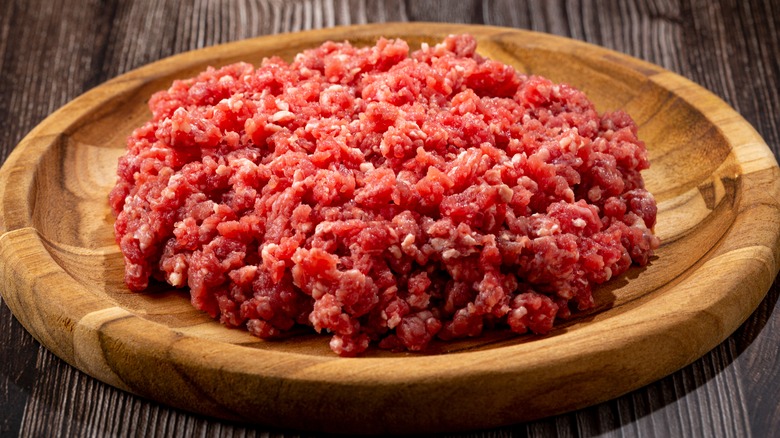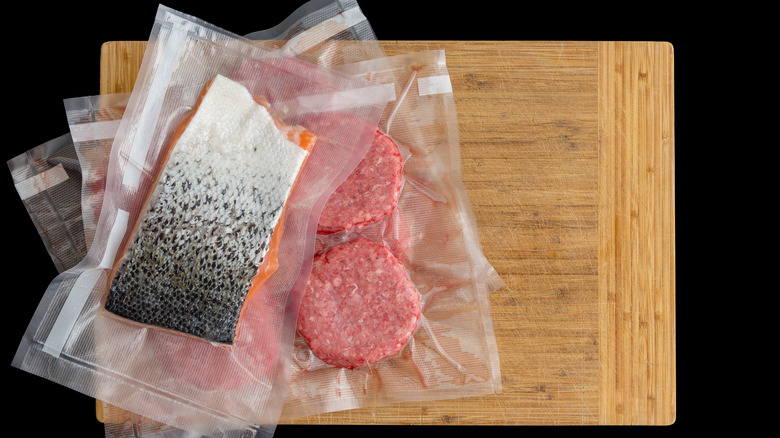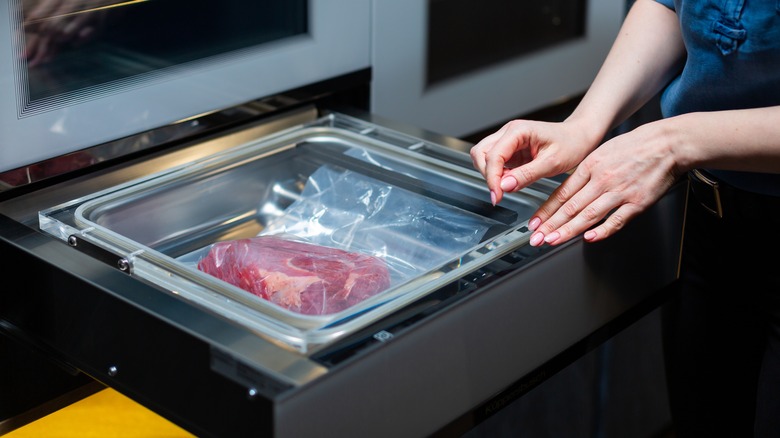Why You Should Vacuum Seal Ground Beef Before Freezing It
The freezer is a simple and effective tool for long-term food storage. According to the United States Department of Agriculture, properly frozen food is essentially safe for consumption forever — only its quality suffers with time. But eventually, all frozen food is subjected to "freezer burn," a disappointing end to the ingredients you carefully prepared and planned to eat at a later date. To retain taste, texture, and color, turn to vacuum sealing: the best thing that's happened to freezing since electricity.
Vacuum sealing was invented in the 1940s, but wasn't used extensively until the '60s, per AMAC Technologies. Since then, it's been adopted by a wide variety of industries and vacuum sealers themselves have improved in terms of efficiency and ease of use. One of the most commonly vac-sealed household staples is ground beef. It's often sold (and purchased) in large quantities, and it's a family-friend base for countless ground beef recipes including burgers, meatloaf, meatballs, stir fries, and many others. Here's why you should always vacuum seal your ground beef before long-term freezer storage, plus some other meat-freezing tips.
How vacuum sealing works
According to Consumer Reports, vacuum sealers work by removing the air from the purpose-built plastic bag that holds your food, and using heat to melt the bag closed. Without oxygen, there's less chance that ice crystals can form, thus preserving the gastronomical qualities and visual appeal of your eats, Consumer Reports adds. Southern Living explains that vacuum-sealed ground beef retains its dark reddish color and keeps for longer than ground beef packaged using other methods. Because of ground beef's loose composition, an airtight seal keeps ice crystals out of all its nooks and crannies so that your next meaty meal tastes its freshest.
FoodSaver, makers of popular home vacuum sealers, explains that vacuum sealing also slows bacterial growth — making it useful even for foods that don't require refrigeration. They also illustrate that vacuum-sealed meat and freezer fish can last two to three years in the freezer compared to six months with other storage methods. To vacuum seal your ground beef with a countertop sealer, you simply divide it into your desired portions, place it into precut vacuum seal bags (or cut them to size yourself from rolls), and seal according to the appliance's instructions. Be sure to leave room in the bag above your food when sealing, FoodSaver adds. Remember to label and date everything — you might not recall the contents months or years later.
Other vacuum sealer uses and tips
Consumer Reports reminds us that vacuum sealers are also useful for sous vide cooking. FoodSaver recommends vacuum sealing meats during marination — try it to infuse your ground beef, steaks, chicken, and chops with flavor much faster. They also explain that you can blanch and vac seal veggies for freezing, and even use the seal function to close up snack bags. You can even buy reusable bags to cut down on plastic waste, FoodSaver adds. But while vacuum sealing is wonderful, there are a few additional pointers to consider when you're doing it regularly.
Honest Food Talks explains that pre-freezing meat (or keeping it frozen) prior to sealing it is the best way to halt bacterial growth and retain all the meat's natural juices. They also write that you can use wax paper to cover foods that might puncture your vac seal bags, like sharp bones, and remind home cooks to check their bags (and perform a freezer seal inspection). America's Test Kitchen explains that labeling your bags before filling them with food is the way to go. ATK adds that flat packages save room in your fridge or sous vide cooker, and warns that liquids should be pre-frozen to avoid a costly mess. Lastly, when handling your vac-sealed frozen items, never pick them up or move them by their excess plastic, as this can compromise the seal. With a little patience and practice, you'll save food and money with your vacuum sealer.


